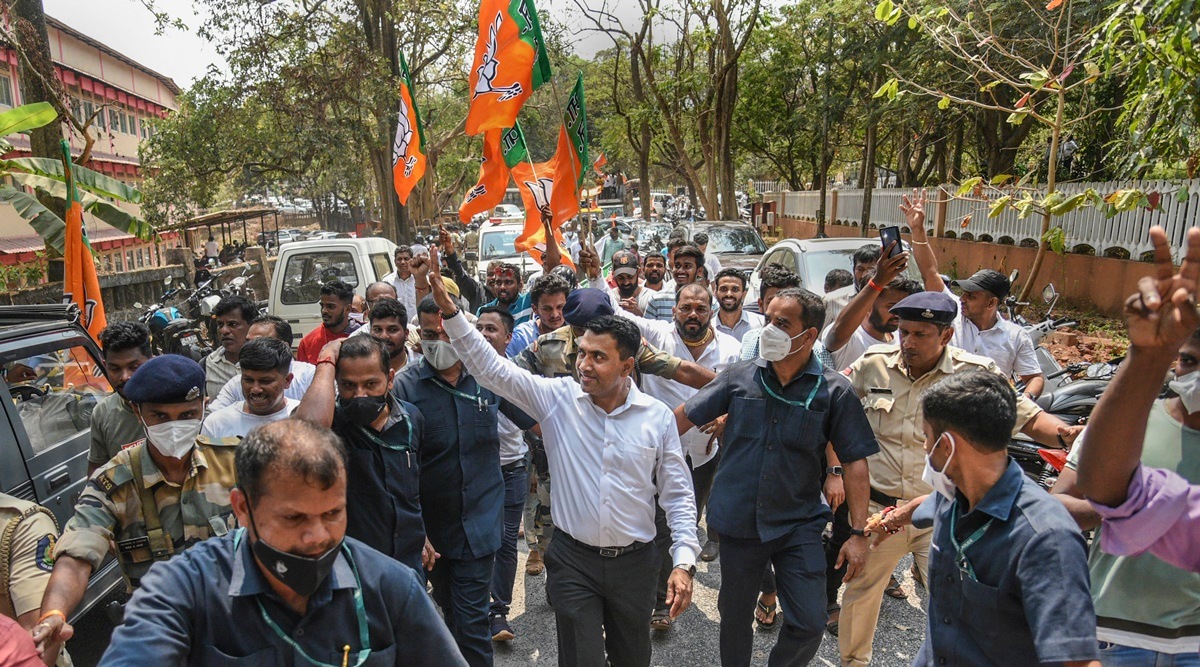Updated: March 10, 2022 11:04:27 pm
 Goa Chief Minister Pramod Sawant flashes the victory sign as BJP leads, during counting day of Goa elections, in Panaji, Thursday, March 10, 2022. (PTI)
Goa Chief Minister Pramod Sawant flashes the victory sign as BJP leads, during counting day of Goa elections, in Panaji, Thursday, March 10, 2022. (PTI) Written by Manoj S Kamat
The election results in Goa have come as a shock to many. The single-party mandate in favour of the BJP, amidst a fractured opposition and contrary to expectations, makes this election distinct from the rest. The nail-biting moments during the counting finally resulted in the BJP inching closer to the majority, with 20 seats in the 40-member Assembly. With the aid of three independents, the BJP is on its way to forming a popular government for the third consecutive time in the state.
The Congress euphoria has died down, with the party managing a meagre 12 seats, including one seat for their alliance partner, Goa Forward Party (GFP). The prospects of the relatively new entrant in the state, the Trinamool Congress (TMC), have been razed, and the hope of the Maharastrawadi Gomantak Party (MGP) that it will turn out to be the kingmaker has been shattered. The painstaking groundwork of the Aam Aadmi Party (AAP) has helped it to open its account in the coastal state with two seats. Against the expectations of the exit pollsters, the radical regional outfit, the Revolutionary Goans (RG), has a maiden victory, although with a slender margin.
The electoral contest in Goa this time has been a close, five-cornered contest. Political optics were hazy, as the limited political space, with an average of 30,000-35,000 voters in each constituency, was crowded with more organised and resource-rich players like the TMC and AAP, alongside the traditional parties, the BJP and the Congress, and regional outfits like the MGP, GFP and RG.
The BJP, with its battery of astute observers from the Centre, took no chances and was quick to adapt. After all, it had to defend its 10 years in government, with four chief ministers in the last two terms. For the Congress, it was an existential battle. From being the single-largest party with 17 seats and yet failing to elect its leader and form the government in 2017, the grand old party was reduced to just two legislators in 2022. Defections gave a big blow to the rank and file of the party. With one former CM, Luizinho Faleiro, joining the TMC, and another former CM, Pratapsingh Rane, backing out from the contest, it was the other former CM, Digambar Kamat, who single-handedly had to lead the dilapidated Congress.
The BJP’s organisational strength has delivered in its favour. Despite the double anti-incumbency, it was able to retain its vote share at 33 per cent. The party had secured just 13 seats with the same vote share during the last assembly election in 2017. Its comprehensive victory seems significant as this party faced a lot of internal bickering in the run-up to the present elections. The spat between CM Pramod Sawant and Vishwajit Rane, a heavyweight leader who switched from the Congress, the Covid crisis, alleged recruitment scams, a financial debacle in the state and the closure of mining for over a decade, presented the BJP with tough challenges. Moreover, this was the first election the BJP was facing without its tallest leader, Manohar Parrikar.
The results mean that the BJP’s intrinsic vote share remains intact. The narrative of the principal opposition party, the Congress, that it now represents a “New Congress”, is stumped by the BJP’s “seat-by-seat micro plans”.
The BJP got an edge due to its offensive strategy of massive “take-overs and acquisitions”. It offered tickets to as many as 12 defectors and in the run-up to the polls managed to poach as many as five winnable candidates from other parties in the 33 seats that it seriously contested.
Much of the credit for the win goes to those who defected from the Congress, adding over 60,000 votes for the BJP. The “individual effort” of the imported and poached leaders compensated for any loss due to anti-incumbency and helped the BJP retain its decisive electoral position in Goa’s politics. Among the 36 candidates that the BJP fielded, three were fresh faces (all won) and five were former legislators who had lost in 2017. Four among these five were able to gain voters’ confidence this time. Of the 12 defectors from Congress fielded by the BJP, five lost, and yet they were able to transfer their massive vote banks to the BJP kitty.
The narrative of the “New Congress” got no electoral sympathy, as there was no attempt to consolidate the opposition vote. The Congress failed to reach out to the MGP, neither did it pay any heed to the TMC’s overtures for an alliance. The GFP’s call to come together and strategise was heard only at the last minute. The Congress’s overconfidence about bipolarity in the contest led to its self-destruction. The five per cent dip in the Congress vote share led to the loss of six seats. The absence of any strategy to form a credible united opposition has led the Congress to the greatest debacle of this election season.
It is hoped that the current mandate in favour of the BJP will do its best to move Goans away from the worst political experience they have had in the last five years.
The writer is an academician and political commentator
- The Indian Express website has been rated GREEN for its credibility and trustworthiness by Newsguard, a global service that rates news sources for their journalistic standards.

